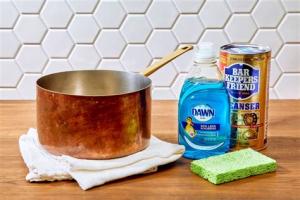Ultimate Guide on How to Clean Copper: Expert Tips & Techniques

-
Quick Links:
- Introduction
- Understanding Copper
- Why Clean Copper?
- Basic Cleaning Methods
- Natural Cleaning Solutions
- Commercial Cleaning Products
- Step-by-Step Cleaning Guide
- Maintaining Clean Copper
- Case Studies
- Expert Insights
- FAQs
Introduction
Copper is a versatile metal known for its excellent conductivity and beautiful aesthetic appeal. From cookware to decorative items, copper has been cherished for centuries. However, it requires proper cleaning and maintenance to retain its shine and functionality. In this guide, we will explore various methods to clean copper effectively, catering to both natural and commercial solutions.
Understanding Copper
Copper is a reddish-brown metal that is not only aesthetically pleasing but also possesses antimicrobial properties. Understanding the composition and characteristics of copper is crucial for effective cleaning and maintenance. Copper tarnishes due to the oxidation process, which occurs when it is exposed to air and moisture.
Why Clean Copper?
Cleaning copper is essential for several reasons:
- Aesthetic Appeal: Clean copper looks stunning and can enhance the beauty of your home.
- Prevent Corrosion: Regular cleaning helps prevent tarnishing and extends the lifespan of copper items.
- Health Benefits: Untarnished copper surfaces are more hygienic, especially in cookware.
Basic Cleaning Methods
There are several basic methods to clean copper, ranging from simple household items to more specialized cleaning solutions. Here are some common techniques:
- Soap and Water: A straightforward method for lightly tarnished copper.
- Baking Soda Paste: A mixture of baking soda and water can effectively remove tarnish.
- Vinegar and Salt: This combination is a powerful natural cleaner for copper.
Natural Cleaning Solutions
If you prefer eco-friendly cleaning options, several natural solutions can help restore the shine of your copper items:
- Lemon and Baking Soda: The acidity of lemon combined with the abrasiveness of baking soda works wonders.
- Tomato Paste: The acidity in tomatoes can lift tarnish from copper surfaces.
- Ketchup: Surprisingly effective, ketchup can be used to clean copper due to its acidity.
Commercial Cleaning Products
For those who prefer ready-made solutions, there are many commercial products dedicated to cleaning copper:
- Copper Cleaners: Specialized cleaners designed to remove tarnish effectively.
- Metal Polishes: These products often contain abrasives and chemicals to polish copper.
Step-by-Step Cleaning Guide
Follow this comprehensive step-by-step guide to effectively clean your copper items:
Step 1: Gather Your Materials
Collect the necessary materials based on your chosen cleaning method, such as:
- Baking soda
- Vinegar
- Lemon
- Soft cloths or sponges
- Commercial copper cleaner (optional)
Step 2: Initial Rinse
Start by rinsing your copper item under warm water to remove surface dirt.
Step 3: Apply Cleaning Solution
Depending on the method chosen, apply the cleaning solution to the tarnished areas. For natural solutions, create a paste and apply it generously.
Step 4: Scrub Gently
Using a soft cloth or sponge, gently scrub the copper surface. Avoid using abrasive materials that could scratch the metal.
Step 5: Rinse and Dry
After scrubbing, rinse the item thoroughly with warm water to remove all cleaning residues. Dry it immediately with a soft cloth to prevent water spots.
Maintaining Clean Copper
To keep your copper items looking their best, consider the following maintenance tips:
- Regular Cleaning: Establish a routine cleaning schedule based on how often you use the item.
- Protective Coating: Consider applying a protective coating to prevent tarnishing.
- Proper Storage: Store copper items in a dry place to minimize exposure to moisture.
Case Studies
Let's explore some real-world examples of effective copper cleaning:
Case Study 1: Restoring Vintage Copper Cookware
A home cook found a set of vintage copper pots tarnished over years. Using a vinegar and salt mixture, she restored their shine and has since maintained them with regular cleaning.
Case Study 2: Copper Decorative Items
An interior designer employed a commercial copper cleaner to restore a tarnished copper vase, achieving stunning results for a client presentation.
Expert Insights
Experts recommend using natural cleaning methods as the first line of defense against tarnish. They emphasize the importance of gentle cleaning to preserve the integrity of copper items.
FAQs
1. How often should I clean my copper items?
It depends on usage. For cookware, cleaning after each use is recommended. Decorative items can be cleaned every few months.
2. Can I use steel wool to clean copper?
No, steel wool can scratch and damage the copper surface. Always use soft cloths or sponges.
3. Is it safe to use vinegar on copper?
Yes, vinegar is safe and effective for cleaning copper when used properly.
4. What is the best homemade copper cleaner?
A mixture of lemon juice and baking soda is one of the best homemade cleaners for copper.
5. How do I prevent copper from tarnishing?
Store copper items in a dry place and consider applying a protective coating to reduce exposure to air and moisture.
6. Can I clean lacquered copper?
Do not use abrasive cleaners on lacquered copper, as they can damage the finish. Wipe with a damp cloth instead.
7. What should I do if my copper item has deep tarnish?
For deep tarnish, consider soaking the item in a vinegar solution or using a commercial copper cleaner.
8. Is it okay to use commercial copper cleaners regularly?
Use commercial cleaners sparingly to avoid over-polishing, which can wear down the copper over time.
9. How can I tell if my copper item is tarnished?
Tarnished copper will appear dull and may have a greenish or dark coating. A shiny surface indicates it is clean.
10. Are there any special precautions I should take when cleaning copper?
Always test any cleaning solution on a small area first and avoid using abrasive materials to prevent scratches.